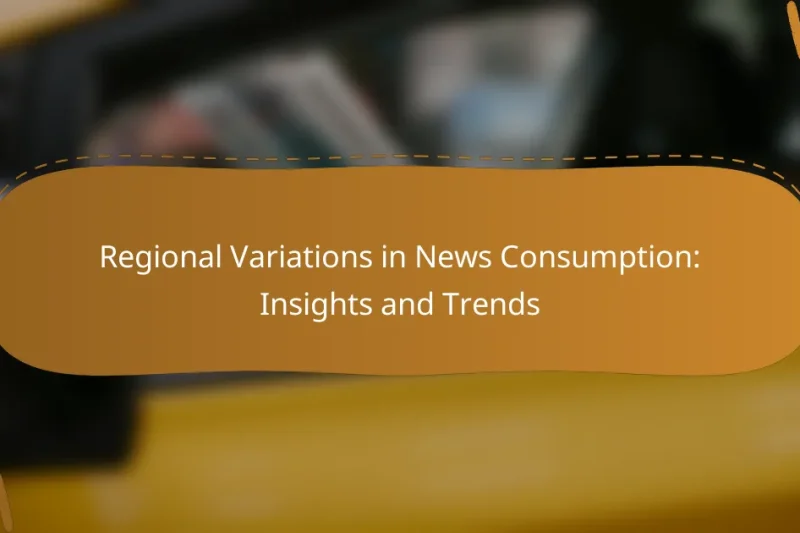Economic factors play a pivotal role in shaping subscription choices among consumers in the US, influencing … Economic Factors: Subscription Choices and Consumer BehaviorRead more
Consumer Behavior in Global News Consumption
Consumer behavior in global news consumption has evolved significantly with the rise of digital platforms, leading to a preference for quick and convenient access to information. Factors such as trust in news sources, social media algorithms, and cultural context play crucial roles in shaping how individuals engage with news content. Understanding these dynamics is essential for navigating the increasingly complex landscape of news media.
Regional Variations in News Consumption: Insights and Trends
Regional variations play a crucial role in shaping news consumption patterns, influenced by local culture, media … Regional Variations in News Consumption: Insights and TrendsRead more
Generational News Consumption: Preferences, Trends and Insights
In the United States, news consumption patterns reveal stark differences across generations, driven by technological preferences … Generational News Consumption: Preferences, Trends and InsightsRead more
Visual Content: Reader Retention Rates and Engagement
Visual content plays a crucial role in enhancing reader retention and engagement by transforming complex information … Visual Content: Reader Retention Rates and EngagementRead more
Recommendations: Influence on News Article Selection
Recommendations significantly influence the selection of news articles by customizing content to match individual reader preferences. … Recommendations: Influence on News Article SelectionRead more
Personalization in News: Impact, Benefits and User Experience
Personalization in news consumption plays a crucial role in enhancing user experience by curating content that … Personalization in News: Impact, Benefits and User ExperienceRead more
Time Constraints: News Consumption Patterns for Professionals
Time constraints play a crucial role in shaping how professionals engage with news, often leading them … Time Constraints: News Consumption Patterns for ProfessionalsRead more
How do consumers engage with global news?
Consumers engage with global news primarily through digital platforms, utilizing various channels to access information quickly and conveniently. This engagement is characterized by a shift towards online sources, reflecting changing preferences in how news is consumed.
Increased digital consumption
The rise of the internet has dramatically changed how consumers access global news, with many turning to websites and social media for real-time updates. Research indicates that a significant portion of the population now prefers digital formats over traditional print media, with online news consumption growing steadily over the years.
Consumers often seek news that is easily shareable and accessible, leading to a preference for platforms that provide instant updates. Popular sources include news aggregators, dedicated news apps, and social media platforms, which allow users to curate their news feeds according to their interests.
Preference for mobile platforms
Mobile platforms have become the dominant means of accessing global news, driven by the widespread use of smartphones. Many consumers favor mobile apps and responsive websites that offer a seamless experience, enabling them to stay informed while on the go.
With the average user spending a considerable amount of time on mobile devices, news organizations are increasingly optimizing their content for mobile consumption. This includes shorter articles, video summaries, and push notifications to keep users engaged and informed in real-time.
What factors influence news consumption behavior?
Several factors shape news consumption behavior, including trust in news sources and the influence of social media algorithms. Understanding these elements can help individuals navigate the complex landscape of news media effectively.
Trust in news sources
Trust in news sources significantly affects how consumers engage with news content. When individuals perceive a news outlet as credible, they are more likely to consume and share its information. Factors contributing to trust include the outlet’s reputation, transparency in reporting, and adherence to journalistic standards.
To build trust, news organizations should prioritize accuracy, provide clear sourcing, and engage with their audience. Consumers can enhance their news consumption by verifying sources and seeking diverse perspectives to avoid echo chambers.
Impact of social media algorithms
Social media algorithms play a crucial role in determining which news stories reach consumers. These algorithms prioritize content based on user engagement, which can lead to the amplification of sensational or biased news. As a result, users may receive a skewed view of current events, impacting their understanding and opinions.
To mitigate the effects of algorithms, consumers should diversify their news feeds by following a variety of sources and actively seeking out reputable journalism. Being aware of algorithmic biases can empower individuals to make more informed choices about the news they consume.
How does cultural context affect news preferences?
Cultural context significantly influences news preferences by shaping what topics are deemed important and how information is consumed. Factors such as values, traditions, and societal norms dictate the types of news that resonate with different audiences.
Regional news significance
Regional news plays a crucial role in informing communities about local issues, events, and developments. For instance, in countries like Germany, local news outlets often prioritize regional politics and community events, which may not receive as much attention in international media.
Understanding the significance of regional news can help media organizations tailor their content to better meet the needs of specific audiences. This can involve highlighting local stories that reflect cultural values or addressing issues that directly impact the community.
Language and accessibility
Language barriers can greatly affect news consumption, as individuals are more likely to engage with content presented in their native language. For example, in multilingual countries such as Canada, news outlets that offer content in both English and French cater to a broader audience.
Ensuring accessibility involves not only language but also the format of news delivery. Providing news in various formats, such as audio, video, or text, can enhance engagement and reach diverse demographics. Media organizations should consider these factors to maximize their audience’s access to information.
What are the trends in global news consumption?
Global news consumption is increasingly characterized by a preference for digital platforms, with significant shifts towards video content and subscription-based models. These trends reflect changing consumer preferences and the evolving landscape of media delivery.
Shift towards video content
There is a notable shift towards video content in global news consumption, driven by the popularity of platforms like YouTube and social media. Consumers are drawn to short, engaging videos that deliver news quickly and visually, often preferring this format over traditional text-based articles.
This trend has led many news organizations to invest in video production, creating content that is easily shareable and accessible on mobile devices. For example, news outlets are increasingly using live streaming for breaking news, allowing real-time engagement with audiences.
Rise of subscription models
The rise of subscription models in news consumption reflects a willingness among consumers to pay for quality journalism. Many readers are opting for paid subscriptions to access premium content, which often includes in-depth analysis and investigative reporting that is not available for free.
This shift is evident in various markets, with many major publications reporting a significant increase in subscriber numbers. For instance, newspapers and online platforms are offering tiered subscription plans, allowing users to choose levels of access based on their preferences and budget.
How do demographics shape news consumption?
Demographics significantly influence how individuals consume news, affecting preferences for content types, platforms, and formats. Factors such as age and educational background play crucial roles in determining these consumption patterns.
Age-related preferences
Age is a key determinant in news consumption habits. Younger audiences, particularly those in their teens and twenties, tend to favor digital platforms like social media and news apps, often consuming short, engaging content. In contrast, older generations may prefer traditional media such as television and newspapers, valuing in-depth reporting and analysis.
For example, individuals aged 18-34 are more likely to access news through mobile devices, while those over 50 often rely on television as their primary news source. Understanding these preferences can help news organizations tailor their content to meet the needs of different age groups.
Educational background impact
Educational attainment influences news consumption by shaping individuals’ interests and their ability to critically engage with content. People with higher education levels often seek out more complex and detailed news stories, favoring in-depth articles and investigative journalism. Conversely, those with lower educational backgrounds may prefer simpler, more straightforward news formats.
Additionally, individuals with advanced degrees are more likely to use multiple sources for news, including international outlets, while those with less formal education may stick to local news sources. This variation highlights the importance of considering educational background when analyzing news consumption trends.
What are the implications for advertisers?
Advertisers must adapt their strategies to the evolving landscape of global news consumption, which is influenced by diverse consumer behaviors and preferences. Understanding these implications can help advertisers effectively reach their target audiences and maximize engagement.
Targeting strategies for different demographics
To effectively reach various demographics, advertisers should tailor their messaging and channels based on age, location, and interests. For instance, younger audiences may prefer social media platforms for news, while older demographics might engage more with traditional news outlets.
Utilizing data analytics can help identify specific preferences within demographics, allowing for personalized advertising. Advertisers should consider segmenting their campaigns to address the unique characteristics of each group, ensuring relevance and resonance.
Ad placements in digital news platforms
Choosing the right ad placements on digital news platforms is crucial for visibility and effectiveness. Advertisers should prioritize high-traffic sections of news websites, such as the homepage or trending topics, to capture attention.
Additionally, native advertising can be a powerful strategy, as it blends seamlessly with editorial content, enhancing user engagement. Advertisers should monitor performance metrics to optimize placements and adjust strategies based on audience interaction and feedback.
What emerging technologies are influencing news consumption?
Emerging technologies such as artificial intelligence, augmented reality, and blockchain are significantly reshaping how news is consumed. These innovations enhance personalization, improve accessibility, and foster trust in news sources.
Artificial intelligence in news curation
Artificial intelligence (AI) plays a crucial role in news curation by analyzing user preferences and behavior to deliver tailored content. Algorithms assess factors like reading habits and engagement levels to recommend articles that align with individual interests.
AI-driven curation can lead to a more engaging experience, but it also raises concerns about echo chambers, where users are exposed only to viewpoints that reinforce their beliefs. Balancing personalized content with diverse perspectives is essential for responsible news consumption.
To effectively utilize AI in news consumption, users should actively seek out a variety of sources and topics. This can help mitigate the risks of algorithmic bias and ensure a well-rounded understanding of current events.






